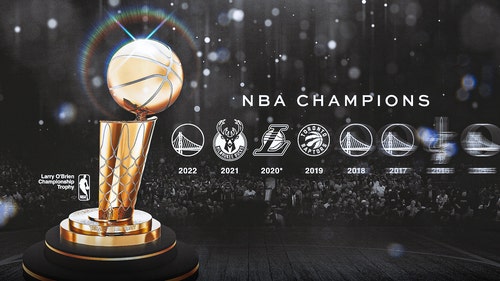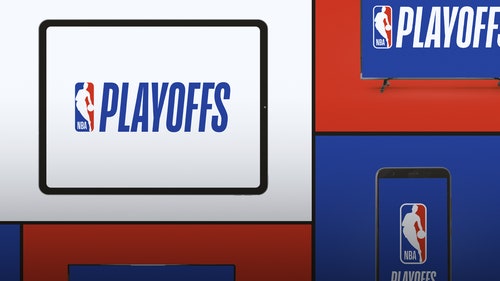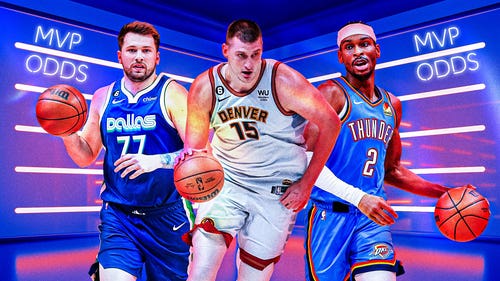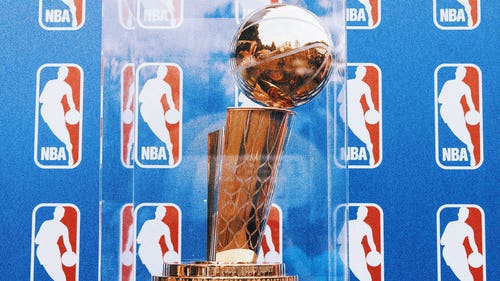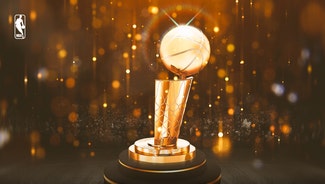
5 Things To Watch In The Jazz-Clippers Series
Mar 25, 2017; Los Angeles, CA, USA; Los Angeles Clippers center Marreese Speights (5) guards Utah Jazz guard George Hill (3) as he drives to the basket in the second half of the game at Staples Center. Clippers won 108-95. Mandatory Credit: Jayne Kamin-Oncea-USA TODAY Sports
With their opponent set, the Utah Jazz will need to prepare to face the Los Angeles Clippers in the first round of the playoffs. Here are the five biggest elements that will define the series.
For the first time since 2012, the Utah Jazz will be making an appearance in the NBA's postseason. Unlike that year, when they were easily bounced in four games, the expectation may be that they fare at least slightly better this time around.
Although they couldn't hold on to the Western Conference's fourth seed, losing their hold on home-court in the first-round by virtue of a tiebreaker with the Los Angeles Clippers, the Jazz are by no means expected to fall early. FiveThirtyEight actually gives Utah a 52 percent chance of advancing to the conference semifinals.
After getting off to a scorching 10-1 start, the Clippers faltered significantly around the middle of the season before regaining form and finishing the year on an 8-2 run. Almost as impressively, the Jazz closed out the year on a 7-3 run, against one of the NBA's hardest schedules.
jazz
Purple and Blues 1 dUtah Jazz: Sloan, Gobert & Bolomboy Win State of Sport Awards
More headlines around FanSided:
1 d - Clippers vs Jazz Playoff Primer1 d - Last Time They Met In The Playoffs: Clippers vs Jazz1 d - History Tells Us Who Is Going To The NBA Finals1 d - NBA Playoffs 2017: Five Bold Predictions For The Western Conference1 d - NBA Playoff Power Rankings: Is A Cavs, Warriors Rubber Match Inevitable?More News at Purple and Blues
Looking only at the regular season head-to-head matchups between the two teams could lead you to believe the Jazz are overmatched against Los Angeles, as they won just one of four meetings this year.
However, as we'll go over, there are several factors that should change the calculus significantly regarding this viewpoint.
Should they manage to win their first series, the Jazz would very likely play the Golden State Warriors – no small challenge, but perhaps one they're up to.
Either way, it's probably not a great idea to be looking so far ahead right now.
Utah doesn't have a ton of playoff experience among the main cogs of its roster, while the Clippers' core four have years of postseason play under their belt together.
This will be one of the main challenges they face, considering Los Angeles will be very motivated to finally get over the hump and reach a conference finals.
Following are five factors, players, and potential events that will prove key to this series.
Mar 13, 2017; Salt Lake City, UT, USA; Utah Jazz forward Gordon Hayward (20) defends against LA Clippers forward Blake Griffin (32) during the fourth quarter at Vivint Smart Home Arena. Utah Jazz won the game 114-108. Mandatory Credit: Chris Nicoll-USA TODAY Sports
Blake Griffin
All eyes will be on Clippers superstar power forward Blake Griffin in this series, for a variety of reasons. For one, it's no secret that Griffin's free agency, which he can trigger this summer by opting out of his current deal, has been circled on the calendar of many front offices around the league for quite some time.
Should the Clippers fall to the Jazz, there's a very real possibility that they blow up their aging core of Chris Paul (31 years old, possible free agent this summer), J.J. Reddick (32, unrestricted free agent), and DeAndre Jordan, who is under contract for the near future but has likely hit his athletic peak at 28 years old.
In the Clippers' four games against the Jazz, Griffin averaged 16.8 points on 48 percent shooting, slightly under the 21.7 points on 50 percent from the field he put up during the regular season. More telling though, was the fact that Griffin managed just eight points on eight shots in the Jazz's 114-108 win on March 13th.
Chris Paul picked up the slack in that game with 33 points, including five three-pointers, but stopping Griffin from getting whatever shot he wanted was an encouraging step.
Griffin is relentless attacking a switch, using his powerful 6'10", 251-pound frame and quirky array of post moves to bludgeon mismatches quickly before help can be effective.
Derrick Favors played in just one of the previous Jazz-Clippers meetings this season. In it, Griffin scored 26, his highest output against the Jazz.
Playing at the 4 alongside Rudy Gobert, Favors just isn't quick enough to match the foot speed and ballhandling ability of Griffin on the perimeter. It's likely Quin Snyder uses combo forwards like Joe Ingles, Joe Johnson, or even Gordon Hayward to stop the Clippers' star, counting on Gobert to protect the paint.
Favors would instead be used more as the backup center he usually plays as, matching up against Marreese Speights or other Clipper bigs.
Forcing role players such as Luc Mbah a Moute to beat you consistently is the best way to stop the Clippers' offense. It's certainly easier said than done, but considering how disruptive Griffin can be, limiting him is paramount to winning.
November 21, 2016; Los Angeles, CA, USA; Los Angeles Clippers guard Chris Paul (3) moves the ball as forward Blake Griffin (32) provides coverage against Toronto Raptors guard Cory Joseph (6) during the second half at Staples Center. Mandatory Credit: Gary A. Vasquez-USA TODAY Sports
The Pick And Roll
With such crafty and talented players like Paul leading their charge, it should be no surprise that the Clippers go to a pick and roll attack early and often. Over the last several years, the pick and roll has grown in use across the league, meaning it is imperative that each team know both how to use it as well as how to slow it down.
According to Synergy, the Clippers as a team go to the pick and roll 17.9 percent of the time, scoring a superb 0.92 points per possession when they do so. Chris Paul in particular keys this effort, orchestrating the action on almost 30 percent of his possessions.
He's shooting a career-high 41 percent from behind the arc, so the Jazz won't have the luxury of going under any high screens Los Angeles sets. This puts a ton of responsibility on Rudy Gobert and whoever else will be defending the screen-setter, as Ben Falk of Cleaning the Glass notes.
The Jazz are putting a lot of pressure on Gobert to be able to keep the ball handler guessing and effectively defend both the ball handler and the roller. Notice that by playing Gobert this way they can still attempt to protect the basket without the weak side defenders having to leave their men much, which takes away kickouts to threes. In exchange they put much less pressure on the ball and concede decent looks in midrange.
When they do need to bring the big out onto the perimeter, Utah will of course be at a disadvantage, but Gobert has shown the quickness necessary to dissuade ballhandlers from beating him for easy buckets.
Rudy Gobert stays in front of Chris Paul, forces a pass and a missed shot: pic.twitter.com/s2KdjhWiLq
— Andy Larsen (@andyblarsen) March 14, 2017
DeAndre Jordan is much less effective posting up or otherwise playing any role aside from the dive man, so the Jazz would do well to shut down the screen game early in this series.
The Jazz are likewise dependent on the pick and roll, although they'll run it through a myriad of player combinations in hopes of exploiting a weakness, which could come in the form of the less-mobile Speights as the defender of the roll man.
That variability may prove key, especially if Utah can learn how to shut down the Clippers' action in that area over a longer series.
Mar 5, 2017; Sacramento, CA, USA; Utah Jazz forward Joe Ingles (2) scores an uncontested three point basket against the Sacramento Kings during the overtime period at Golden 1 Center. The Utah Jazz defeated the Sacramento Kings 110-109 in overtime. Mandatory Credit: Kelley L Cox-USA TODAY Sports
Three-Point Shootout
The modern NBA is more predicated on the three-point shot than ever before, and the Jazz have done fairly well to stay out front of the trend. Although they rank 17th in attempted threes per game, efficient shooting from the likes of Joe Ingles, Gordon Hayward, and others has propelled them to the ninth-best shooting percentage from deep.
As mentioned in the previous slide, the Jazz generally attempt to prevent open threes at the cost of easier midrange looks, which shows, as they allow only 23 attempts per game on average. In comparison, the Clippers rank even higher, making the sixth-highest percentage of their long-range looks.
A large percentage of Los Angeles two-guard J.J. Reddick's threes come either in transition or off of pin-downs and stagger screens, as can be seen in the video below.
Rodney Hood, Dante Exum, or whoever draws Reddick as a matchup at any point will have to commit a ton of energy on the defensive end to chasing the Clippers' shooting guard off and around screens.
Los Angeles doesn't roster a ton of dangerous shooters outside of Reddick and Paul. Austin Rivers, Marrese Speights, and Mbah a Moute are their next highest-volume gunners, but they aren't dangerous to the capacity of the starting backcourt.
Jamal Crawford has made a habit of feasting on the Jazz this season, so expect at least one night where he may turn the tide for his team.
Mar 25, 2017; Los Angeles, CA, USA; Utah Jazz guard George Hill (3) drives to the basket in the second half of the game against the Los Angeles Clippers at Staples Center. Clippers won 108-95. Mandatory Credit: Jayne Kamin-Oncea-USA TODAY Sports
George Hill, Back In A Hurry
Jazz point guard George Hill has missed a lot of time this season due to various injuries, including groin, toe and concussion ailments. His latest groin injury kept him out for six games, the Jazz going 4-2 over that stretch.
Hill only had two games in which to regain form, both wins over the San Antonio Spurs and Golden State Warriors. Surprisingly, he did well in those contests, scoring 13 and 20 points respectively and finishing a combined +20.
Hill will be crucial in this series – he has a wealth of playoff experience gained during his time in the league and will be counted on to stop Paul as well as run the Jazz offense.
In fact, after Hayward and Gobert, Hill might be the most important Jazz player when it comes to swinging the outcome of games.
With a big win over GS last night, the Jazz improved to 15-1 when George Hill scores 20 points or more. No question who the X-Factor is. pic.twitter.com/hoJOEsBkxG
— Taylor Griffin (@griffhoop) April 11, 2017
With so little time to find his footing again, there could be concern over whether Hill will be all the way back come Saturday night and throughout the rest of the series.
Against the Clippers this season, Hill averaged a relatively low 13 points and finished a combined -66; however, he was good for 19 points and a +3 in the Jazz's win. Outside of the stars, Hill will have the most to say about how this series ends up, which makes his injury status more impactful.
Mar 6, 2017; Salt Lake City, UT, USA; Utah Jazz head coach Quin Snyder keeps an eye on the action in the third quarter against the New Orleans Pelicans at Vivint Smart Home Arena. The Utah Jazz defeated the New Orleans Pelicans 88-83. Mandatory Credit: Jeff Swinger-USA TODAY Sports
Tightening the Rotation
The Jazz have been both blessed by depth and cursed by injuries this year. The former has allowed them to absorb the impact of the latter, with role players ready to fill in over a period of days or even weeks.
Luckily, Utah enters the playoffs with a completely healthy (or at least completely available) rotation. This gives them a ton of options. Depending on the matchup, they could run out a small lineup with three guards and Hayward, or go big with Gobert, Favors, Hayward, and Ingles.
More from Hoops Habit
The Jazz do not have a player averaging more than Gordon Hayward's 34.5 minutes per game, as Quin Snyder has preferred to spread playing time over the whole roster.
Twelve out of the 15 players that have suited up for Utah this year are playing more than 15 minutes per game.
In comparison, the Clippers have nine players reaching that threshold, with Griffin being their leader in terms of minutes.
With the stakes higher and the need for long-term rest virtually non-existent, the Jazz could elect to distribute more minutes to their starters, taking time away from the end of the bench.
Even that is tough to say will happen, as Utah's roster is extremely diverse. No role players are truly dispensable in that what they bring to the table can be replicated by others on the team.
A longer series benefits the Jazz in this way – the further both teams have to reach onto their bench, the greater advantage Utah will have due to its depth.
The Jazz have the advantage of the unknown in that they have not ran their ideal starting lineup out many times due to injury. The Clippers will not know what the Jazz's full capacity is, but then again, neither will the Jazz.
Simply coordinating all their talent in one direction will be one of the major issues facing the team, but if they can manage it, they'll have the higher ground.
The Jazz begin their first playoff effort in five years on Saturday night. The result of the series remains up to them.






































































































































